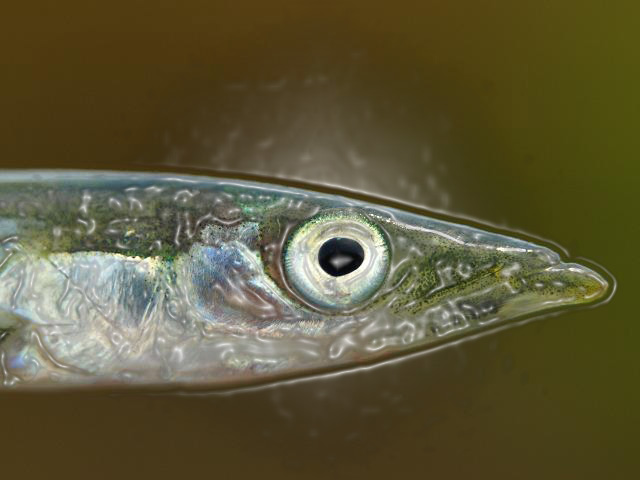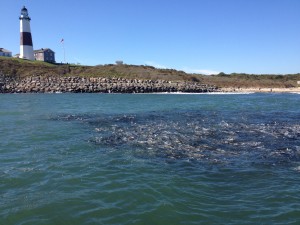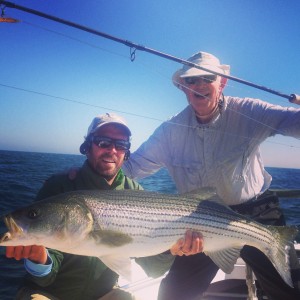[dropcap]I[/dropcap]t is a good feeling to finally finish up a 6 week run of guiding fly fishing trips during Montauk’s fabled Fall Run on the east end of Long Island. While I always look forward to getting home to spend time with my family, this year that sentiment is twofold. The Fall Run barely happened this year and conjecture on how this is possible is rampant amongst guides, captains, surf fisherman, and fly anglers alike. Of all the places in the world, Montauk has the most reliable fall fishing for striped bass, bluefish and false albacore. Fall bass blitzes are essentially a lock in Montauk during the historic four week prime (9/15-10/15). Every year mayhem ensues during this time, for part of it, at least. Not so this year, and I blame the sand eel.
As anyone who has spent a fair bit of time fishing the Fall Run in Montauk knows, anchovies (rainbait) fuel the whole show. Deep, dark reddish brown balls and rafts of bait are what the fish key in on and massacre in those famous Montauk blitzes. Well, not this year. For the most part, the anchovies went largely un-harassed. They
were there on my Raymarine screen everyday, sometime 30 feet down sometimes hanging lazily relaxed just under the surface. So why, you may ask, did the rainbait get the season off? Because, the place was rife with big long sand eels. Nobody chooses meatloaf over prime rib and fish aren’t much different that way. The sand eel is a better meal. They prefer sand eels, and as long as they hang around, the ‘chovies are sitting pretty and enjoying a nice vacation on Long Island’s east end.
These sand eels don’t really school up on the surface. They tend to hang near the bottom until threatened and then make a dart to the surface to flee predators. So from up above, we’d see individual fish come shooting straight out of the water sometimes, as they’d chase a 6- 7-inch sand eel to it’s demise. It is cool to watch and really fun to catch them like this when it is going well. And it did get really good on many days this Fall with this sort of action and large fish on the feed. To succeed, you have to cast a large fly directly on the fresh boil. When done right, it works great but it is tremendously harder than lobbing a Clouser Minnow into a frothing mass of 500 anchovy gorging stripers and staying tight to it until it the line starts
to move. If the sand eels are just popping sporadically, then it becomes quite difficult and requires a good dose of patience and a touch of luck. What I have just outlined was commonplace this Fall and is not what people think of and expect when signing up for Montauk’s epic Fall Run. They think of massive schools of bait, carpets of feeding bass with clouds of terns and gulls overhead. Guides expect to make a right out of the harbor, look for the boiling foam, cut the motor and wait for the sweet sound of a clicking drag. This year was different. Everyone caught plenty of beautiful bass and gorilla blues, but they worked harder for them. This type of bait really spreads the fish out more over a larger area. They become less concentrated and become harder to locate.
My understanding of the situation is that for some reason, we have had an overabundance of sand eels this season that has resulted in different feeding behavior which in turn effects location and accessibility to the angler. I do not know what has lead to this abundance of sand eels and would welcome suggestions or comments on the matter. These sand eels were prevalent throughout the summer as well and lead to catches of many trophy bass at that time as well. So for a good long run during this summer and fall, there was a better quality of fish but seemingly fewer of them. Other strange components of this season include the incredible lack of false albacore and the relative abundance of weakfish and bonito. It wasn’t uncommon this Fall to get into a school of weakfish and end up catching a dozen or so. Randomly, fly fishing boats would end up catching a half a dozen green bonito, out of the blue. These are just a few of the crazy components to this season. It not being your run of the mill season, certainly made it more difficult for the fly fisherman. One seasoned albie junkie (who “tolerates bass and abhors bluefish”) said he’d personally caught 168 albies the previous year to this year’s six caught. He bailed for his Florida crib a tinge early because of it.
So what happened to the rainbait and how will this play out in the seasons to come? That, of course, remains to be seen. Conjecture and informed guesswork is usually what we go on in this sport. My guess is next fall plays out more like the blitzing falls of lore. Mild fall weather and and abundance of eels probably just spread these fish out more than usual this year. The false albacore run has been reported as very good in other notable and historic hot spots (Harker’s, etc…). And who knows, perhaps we will be rewarded with an epic herring run in November to make up for the lackluster blitzes this year. I would take that trade in a New York minute…







